
Whole grain mustard is a staple in my fridge and my kitchen. This paste is an essential condiment in every French home.
You can use it to prepare vinaigrette dressings or to flavor meals. I add a dollop of this grainy mustard to my lentil meals.
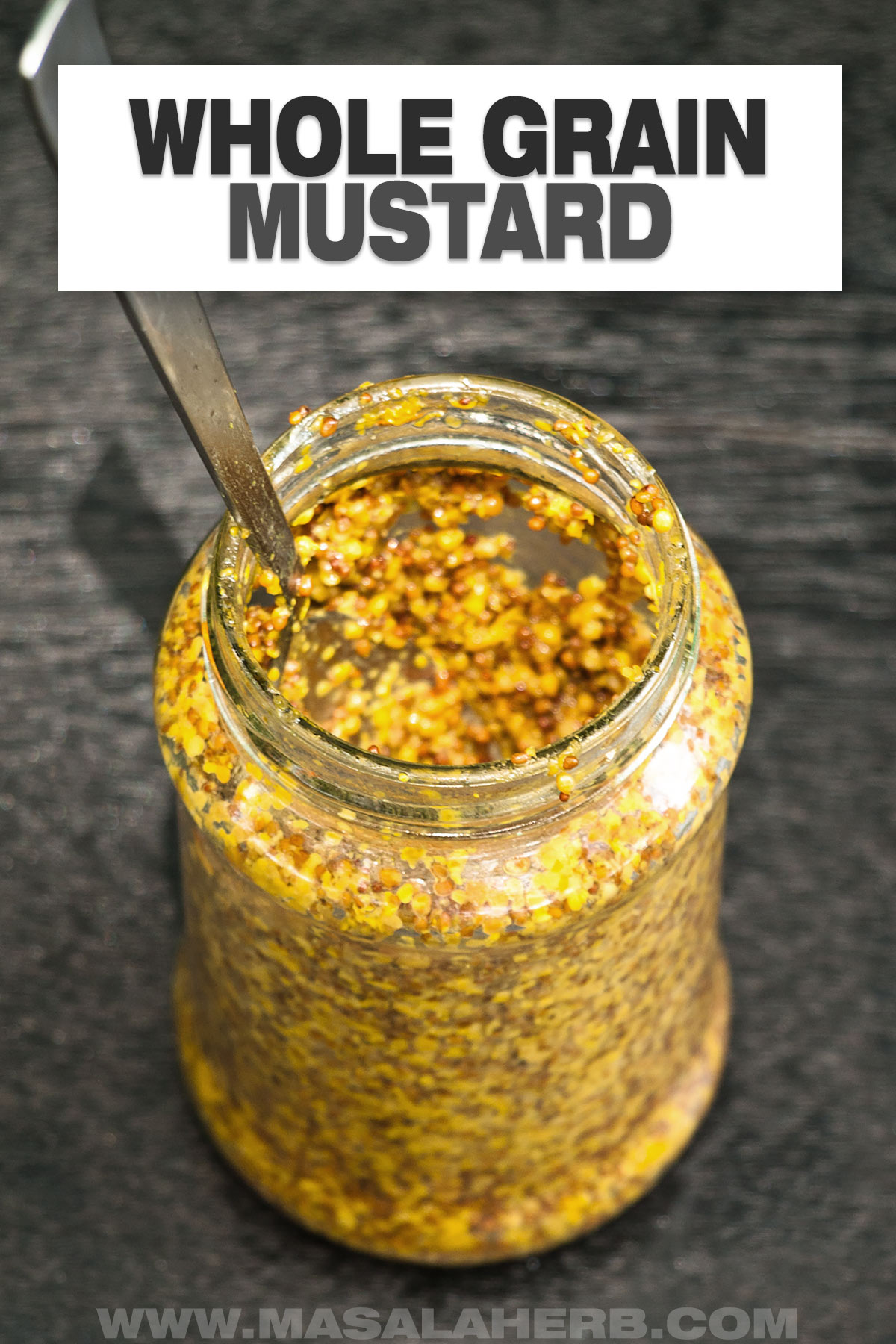
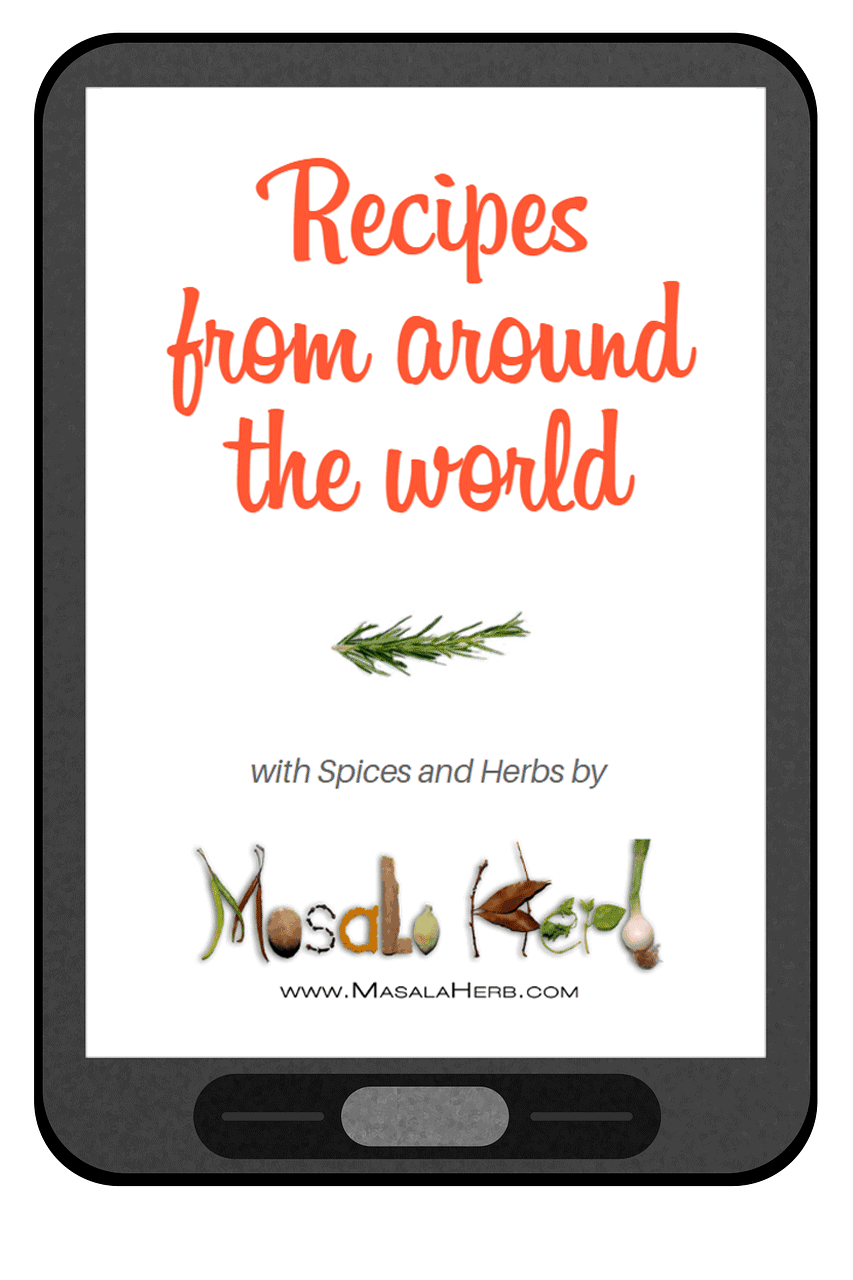
Global Food Recipes
with Spices and Herbs
Free E-Book available for a limited time. Grab yours now and get instantly inspired!
You missed out!
TL;DR
The mustard seed is one of my all-time favorite spices. That might be because my European roots use the yellow seeds commonly in pastes and also because my husband's traditional food culture uses the brown and darker mustard seed versions in Indian cuisine.
Yet, I have noticed that mustard as a spice has often been overlooked and forgotten.
The fact that we commonly buy our mustard pastes ready-made in the Western world got us so far that the mustard seeds almost disappeared from the grocery store shelves and from our kitchens.
However, in the Far and Near East, dark brown and black mustard seeds are more commonly available. In the Western world, bigger yellow mustard seeds are a common sight!
Yet, of course, ready-made mustard pastes in different variations are most popular, such as the classic French Dijon mustard paste, the French Dijon whole grain mustard, or the bright yellow English mustard paste.
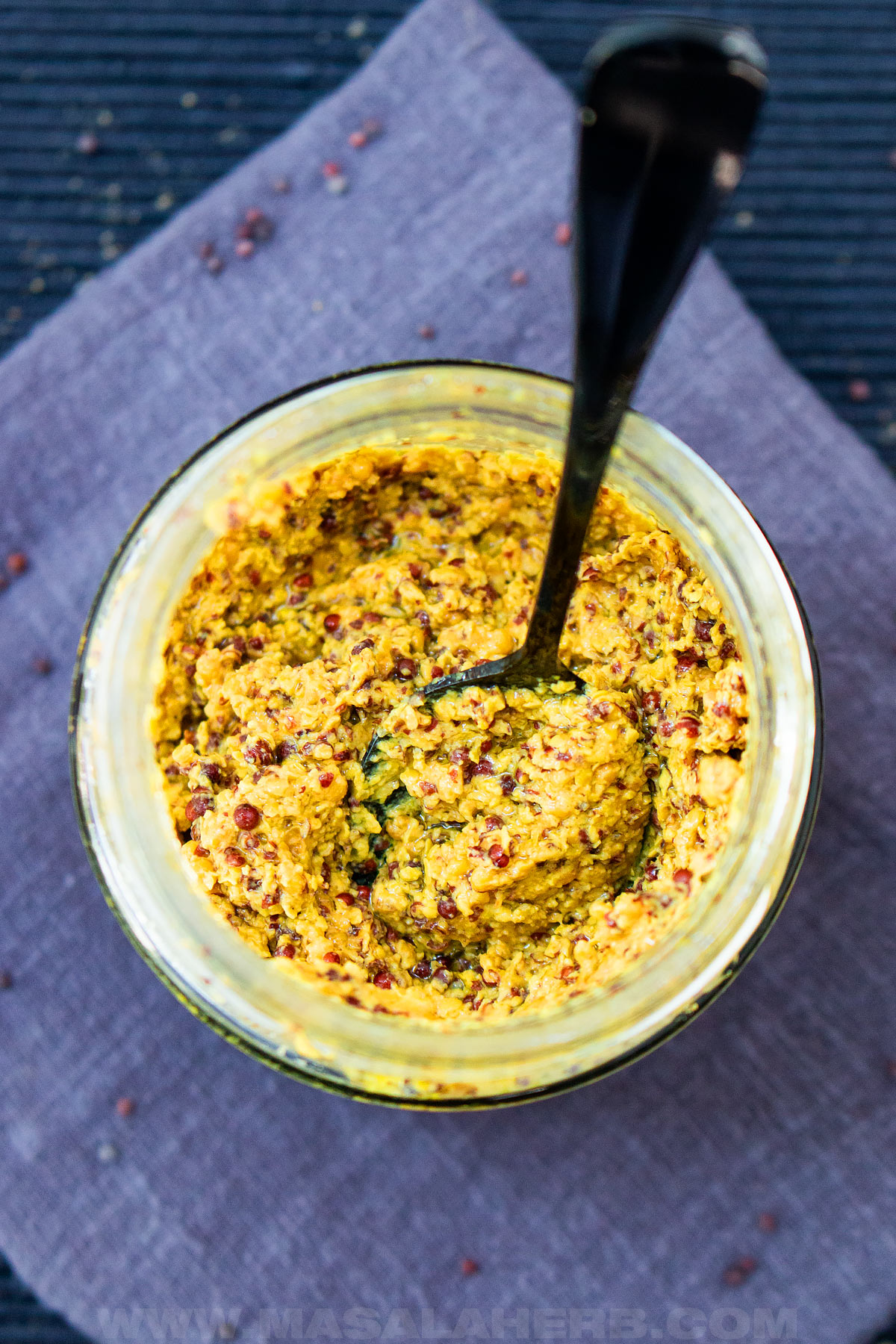
How to make it?
Step 1
Keep the mustard seeds with the vinegar submerged to soak for 1 hour.

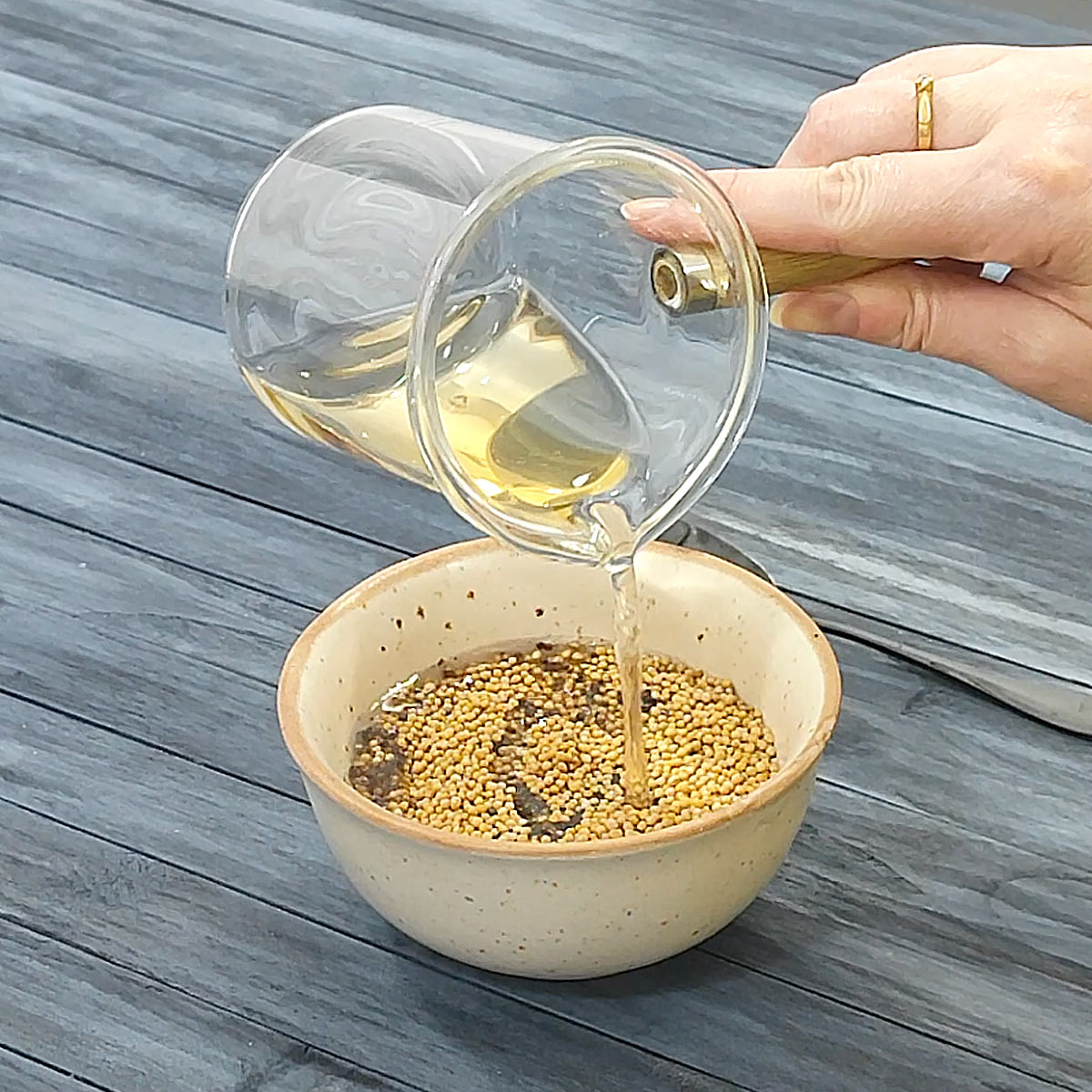
Step 2
Smash or blend the soaked mustard seeds with the vinegar. Use a mortar and pestle OR a food processor.
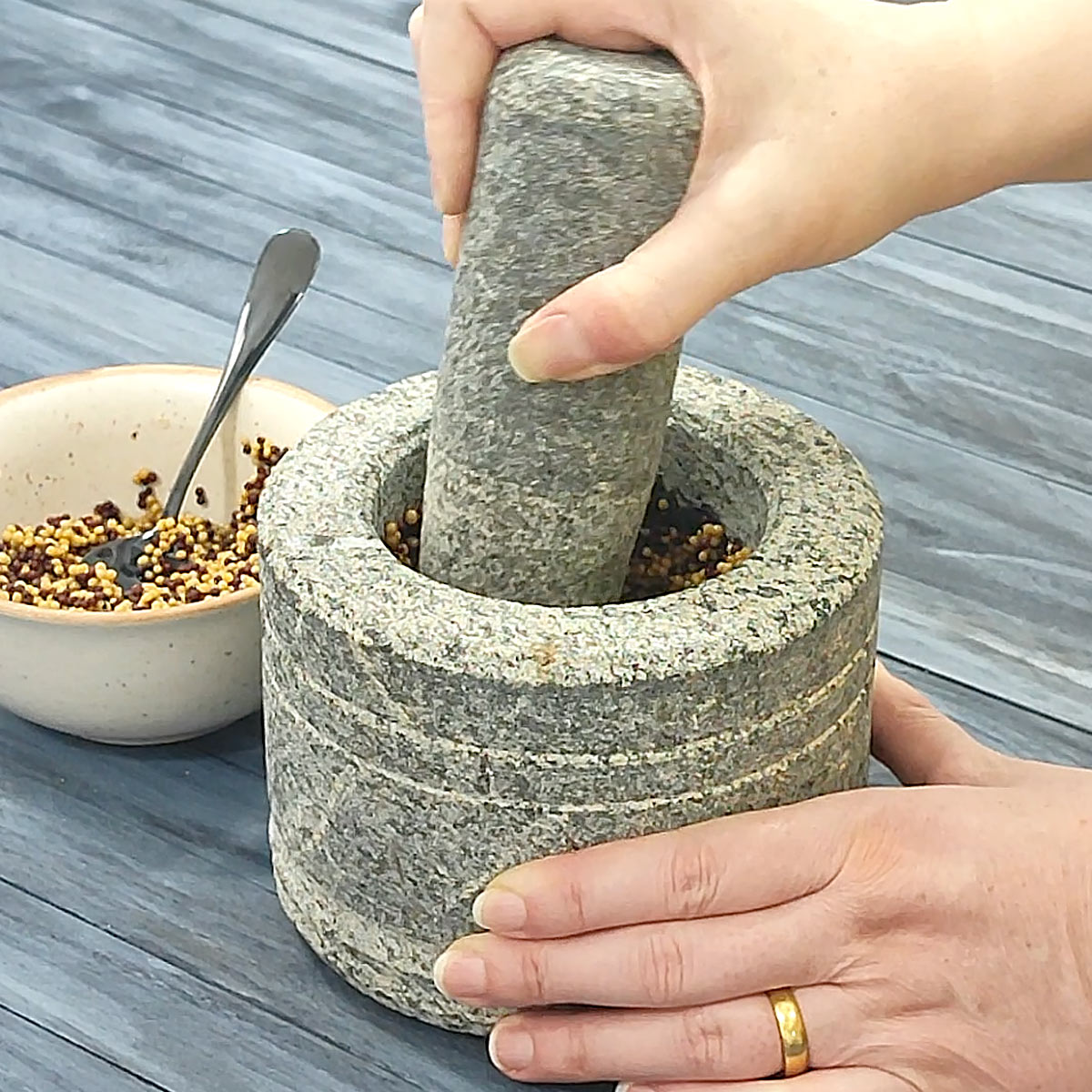
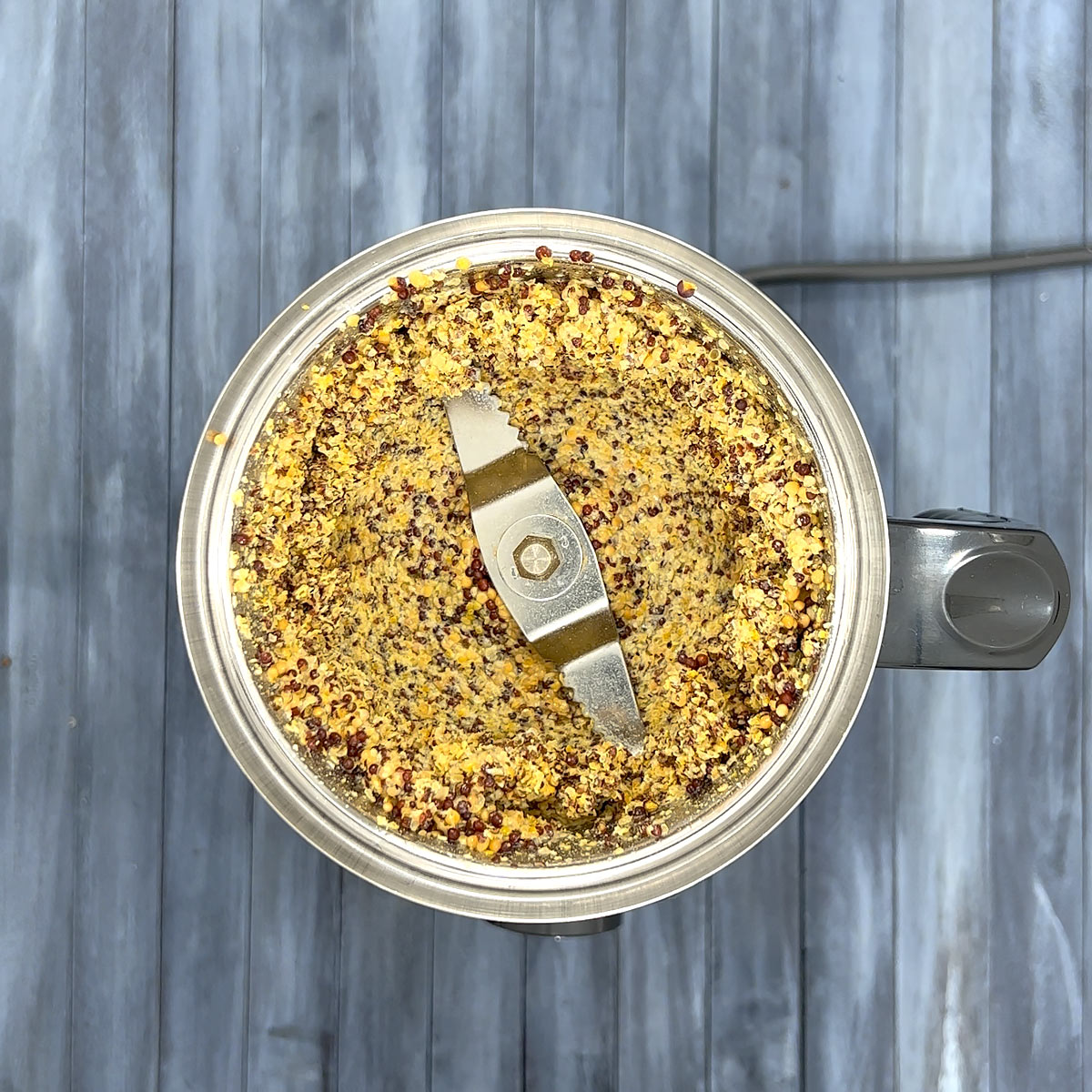
Step 3
Combine the blended mustard paste with the lemon juice, salt, pepper and turmeric powder.
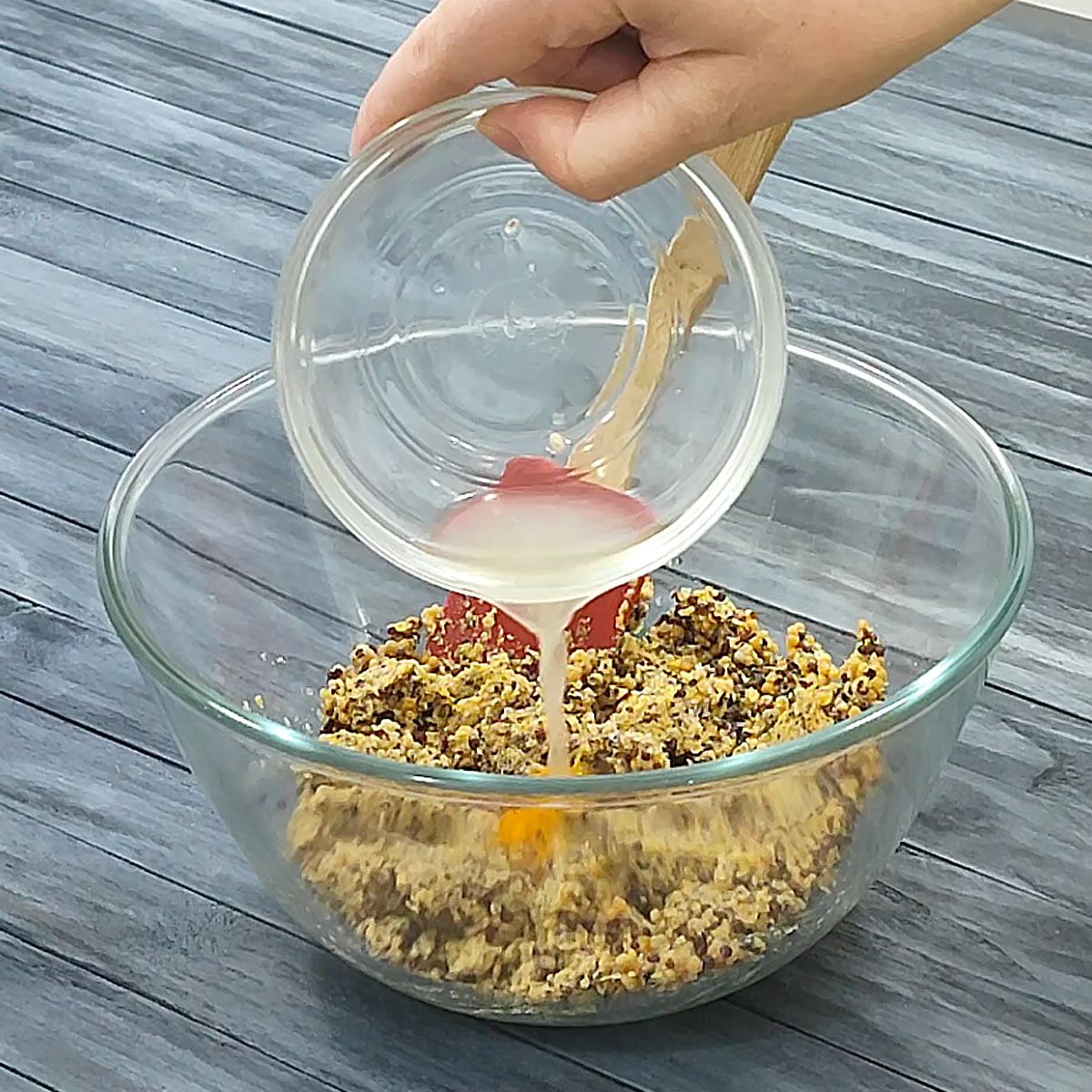
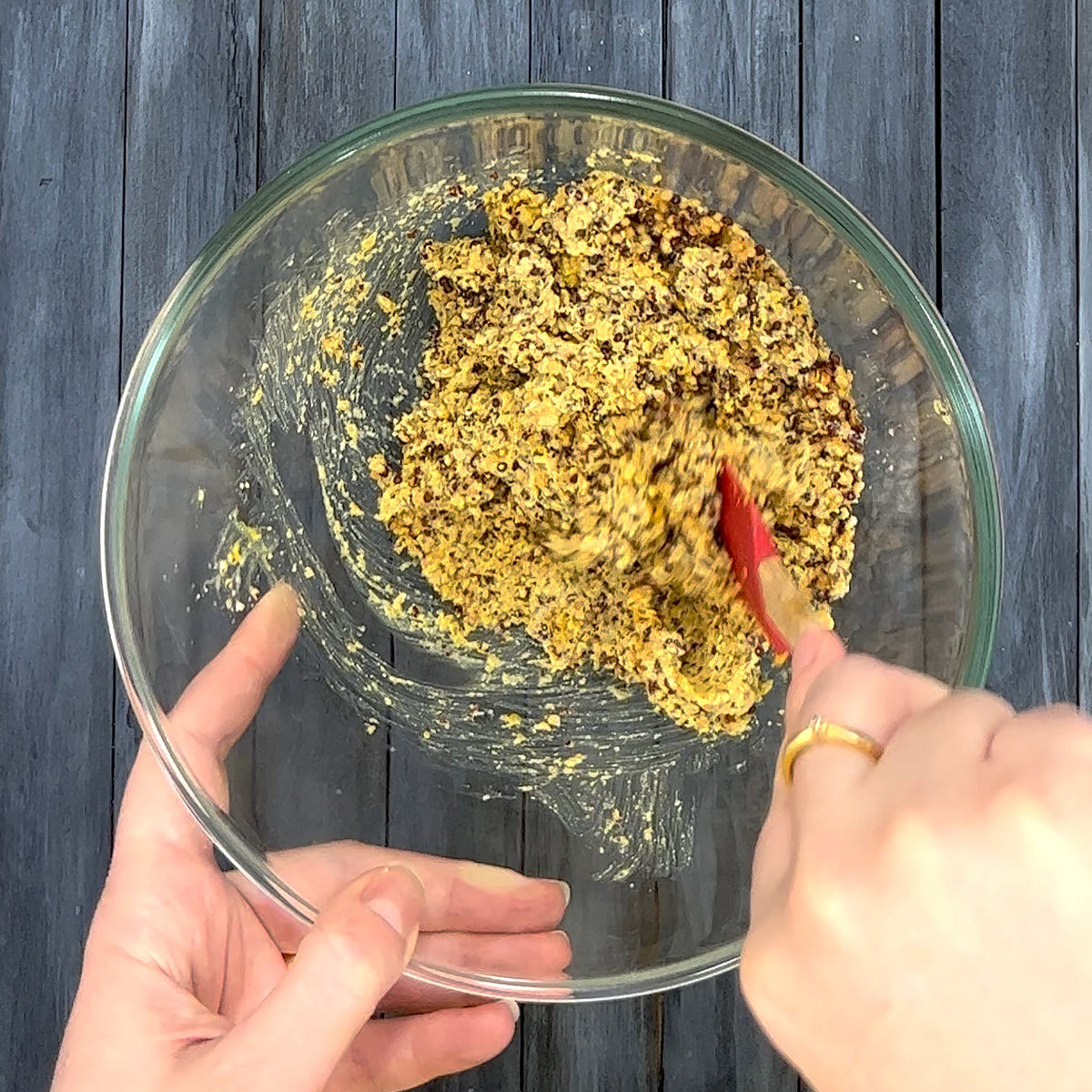
Step 4
Place the condiment into a clean jar. Pour in most of the oil and mix in the oil. Pour the remaining oil over the paste and close the jar.
The condiment needs to “rest” for 4 weeks so that the flavors can develop, and then you can use it as per your needs.
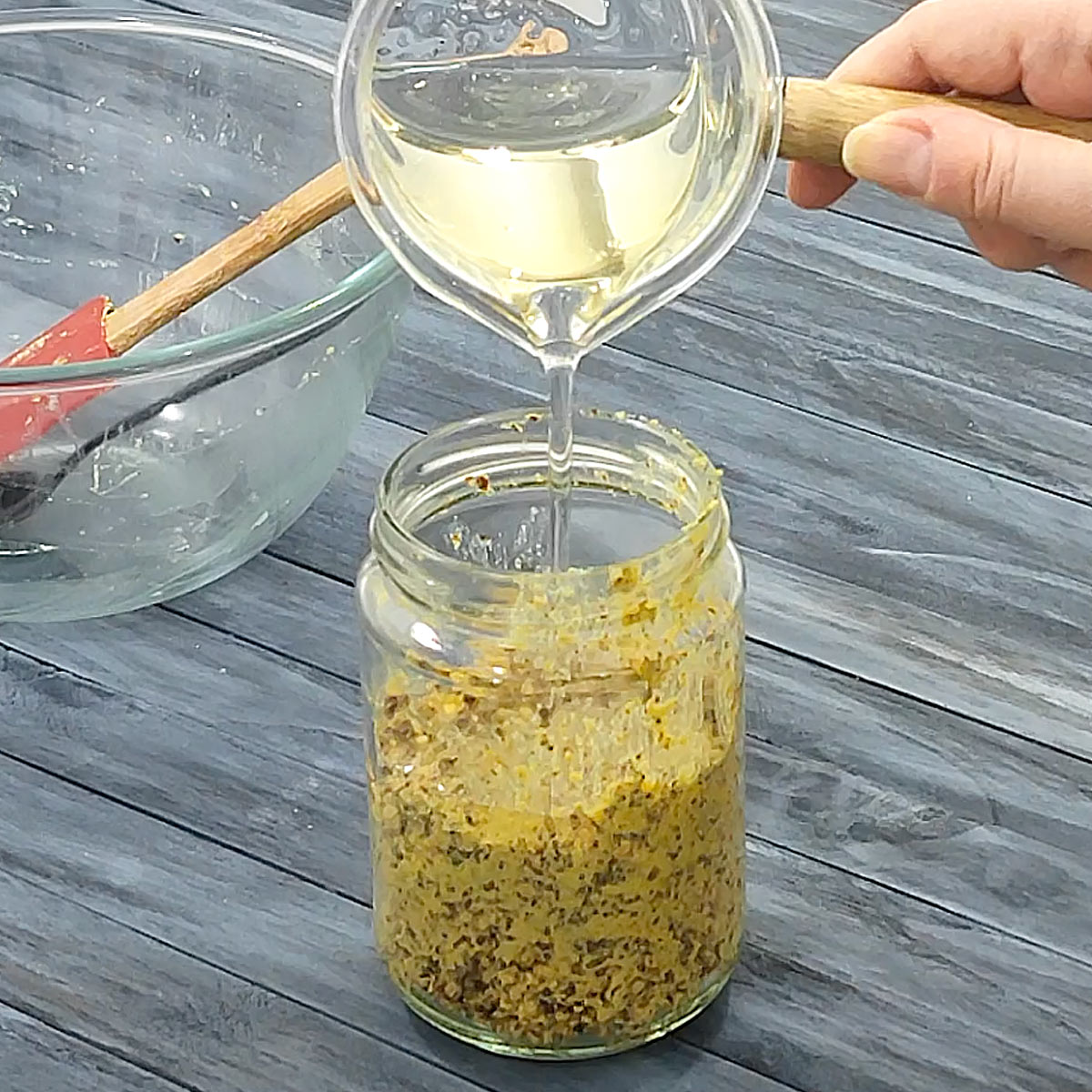
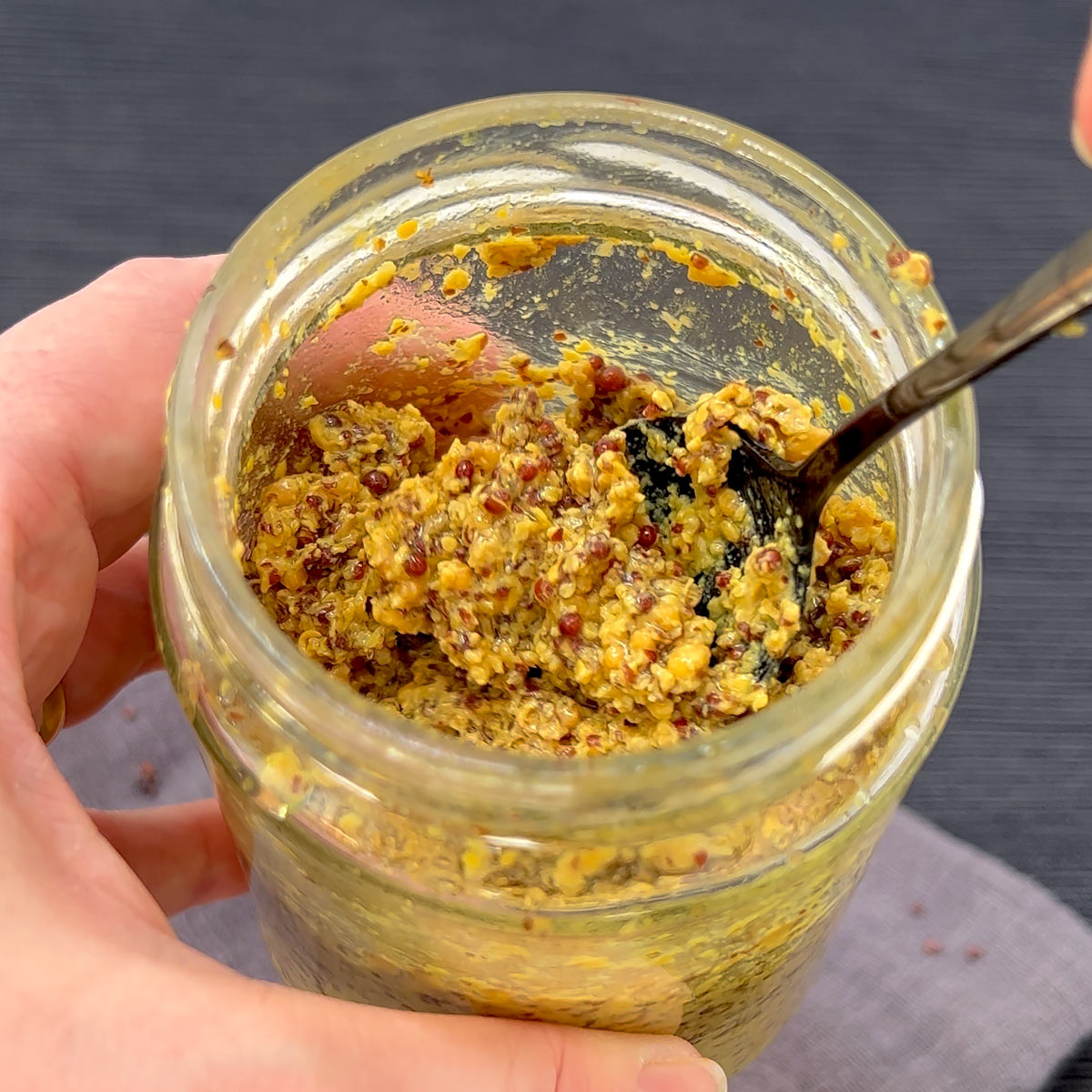
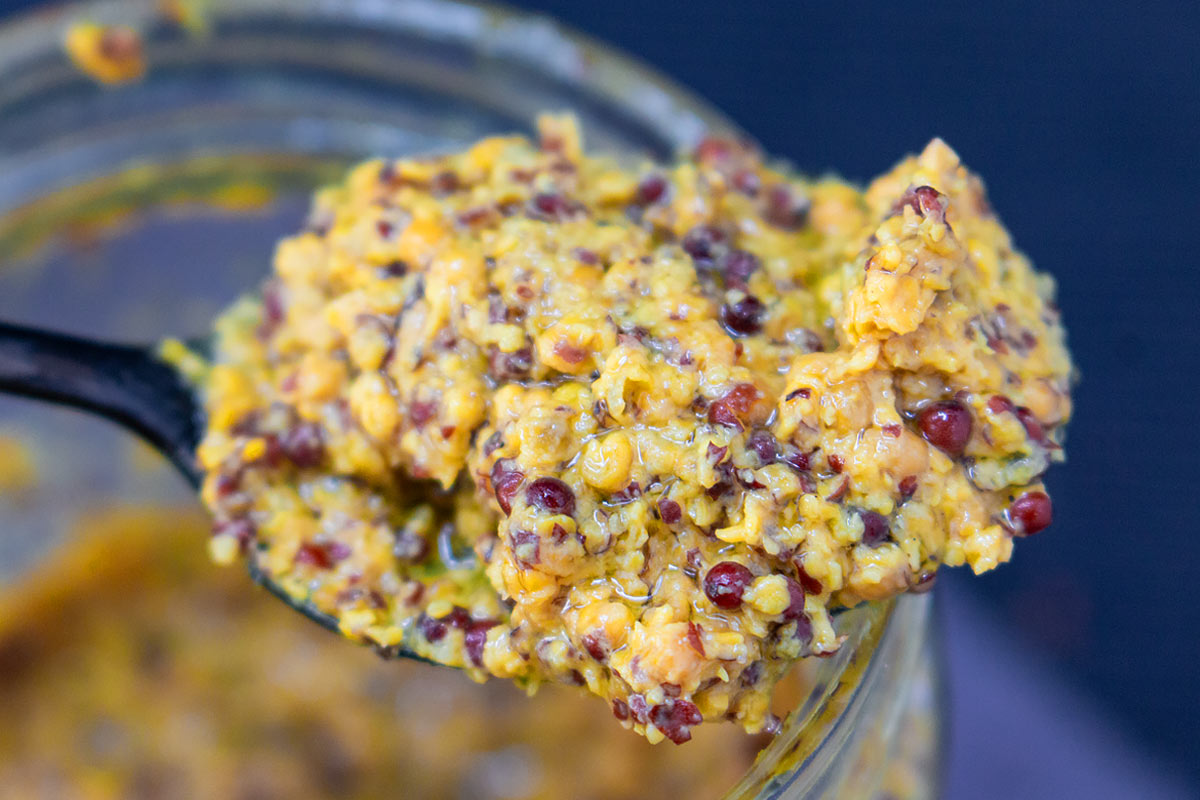
📖 Recipe
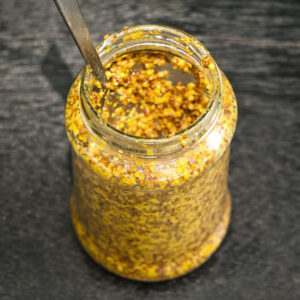
Whole Grain Mustard Recipe
Ingredients
Ingredients:
- ¼ Cup Yellow Mustard Seeds
- ¼ Cup Brown Mustard Seeds
- 9½ Tablespoons White Wine vinegar
- 1 Tablespoon Lemon Juice
- ¼ Teaspoon Salt
- pinch Black Pepper Ground
- ⅛ Teaspoon Turmeric Ground optional
- 3 Tablespoons Oil sunflower or canola oil
Instructions
- Add to a bowl your yellow and brown mustard seeds and cover them with the white wine vinegar. Soak the seeds for one hour. You will notice that the vinegar will bubble a bit when it comes in touch with the mustard seeds, that's alright. We want the seeds to get a bit soft.¼ Cup Yellow Mustard Seeds, ¼ Cup Brown Mustard Seeds, 9½ Tablespoons White Wine vinegar
- Pound or blend the seeds in a food processor. If they have lost a bit of liquid, then add about 1-2 tablespoons of water to the mixture. To pound with the pestle, always add small batches and smash and twist it until most of the yellow seeds have turned into a mush. The brown ones don't crack that easily, but with the pounding, they will crack a bit and emit the flavors.
- In a bowl with the smashed mustard seeds, add the lemon juice, salt, pepper, and turmeric powder. Mix the content well and fill a clean jar with the condiment.1 Tablespoon Lemon Juice, ¼ Teaspoon Salt, pinch Black Pepper Ground, ⅛ Teaspoon Turmeric Ground
- Pour most of the oil into the jar and mix the paste with the oil. Pour remaining oil over the mustard paste and close the jar.3 Tablespoons Oil
- Leave the condiment alone for 4 weeks alone so that the flavors can develop. Keep it out at room temperature if your climate is cold. If it's a hot, humid climate, keep the jar in the fridge after 2 days for the remaining 4 weeks.
Equipment
- Mortar and pestle or food processor
- 1 8 oz Canning Jars 240 ml
Nutrition
Tips
When you make the whole grain mustard condiment, keep in mind that it needs 4-5 weeks to rest before you can enjoy the grainy mustard paste and consume it with your meal.
The longer you keep the seeds to rest/marinate the more flavorful it will be at the end.
In my recipe, I have used White wine vinegar instead of verjuice, and the yellow and dark mustard seed ratio is at 1:1.
Brown and yellow mustard seeds can be easily purchased online, or otherwise look out for mustard seeds in your nearest organic store or ethnic neighborhood grocery store.
In this whole grain mustard recipe, I added a bit more turmeric powder than what they would add in France.
You can adjust the amount of turmeric you would like to add to your copycat Dijon mustard paste. The flavors don't change that much. The color is the main difference and makes the mustard paste pop more.
So that the condiment survives longer, I chose to add more of the antifungal and antibacterial yellow turmeric (Curcuma) spice.


Storing
The paste can be stored in a dry and cool place for months. I usually store the grainy mustard pot in the fridge.
Uses
What is whole grain mustard?
Whole grain mustard is mostly known as whole grain Dijon mustard (from Dijon city in Burgundy, France) or moutard á l'ancienne in French.
Yet as a side note, whole grain or grainy mustard pastes, in general, can be found all over the world in different cuisines. AND there is also a popular ground (non-grainy) Dijon mustard variation.
In this post, we will focus on the whole grain Dijon mustard since this grainy mustard recipe is a Dijon copycat recipe.
It is common knowledge that the making of Dijon mustard, which might be whole grain or ground mustard, is a science and highly secretive recipe of the region in France. Therefore, Dijon mustard received a protected label in the late 1930s.
That means the production has been strictly watched and limited to the region of Burgundy. This whole grain mustard recipe and any other whole grain Dijon style mustard are copycat recipes and can never be sold under the name of Dijon mustard.
So this special protection is just another reason why, generally speaking, Dijon mustard and any other mustard in this world are not the same.
FAQs
The main difference is the mustard grain smoothness. Besides that, whole grain mustard paste is much milder compared to ground mustard paste, all the grainier, and contains mostly a mixture of yellow and black or brown mustard seeds.
The yellow mustard seeds for the ground or whole grain Dijon mustard paste are collected from a certain yellow mustard type, and the seed's “skin” is partially removed. The paste also goes through some kind of fermentation, and the acidity is added with verjuice, a highly acidic juice made by pressing unripe green grapes grown in that region in Burgundy. On the other hand, OTHER French regional whole grain mustard recipes include white wine vinegar, and the procedures and ingredients are different as well. Some recipes even include flour and certain spices such as cumin and turmeric.
In fact, other, non-Dijon mustard pastes that are part of the gourmet mustard paste heritage in France include the green pepper mustard, and the black currant mustard paste. Both are smooth ground mustard pastes.
Mustard seeds, and especially the yellow variety, grow in the Mediterranean area from a small plant into a shrub. The yellow mustard seeds are mostly commercially grown in big quantities in Canada, Russia, and Eastern Europe, such as the Czech Republic and Hungary. Dark brown and dark black mustard seeds are grown in and around the Himalayan region, which includes Nepal, Pakistan, India, Myanmar, and China.
The yellow mustard seeds are often bigger and easier to crush, and they do have a bitter aftertaste. The brown & black mustard seeds are smaller and harder, and I believe they are a bit less pungent compared to their yellow counterparts.
The post Whole Grain Mustard, was first published on January 26t, 2015, and has been updated and enhanced ever since!
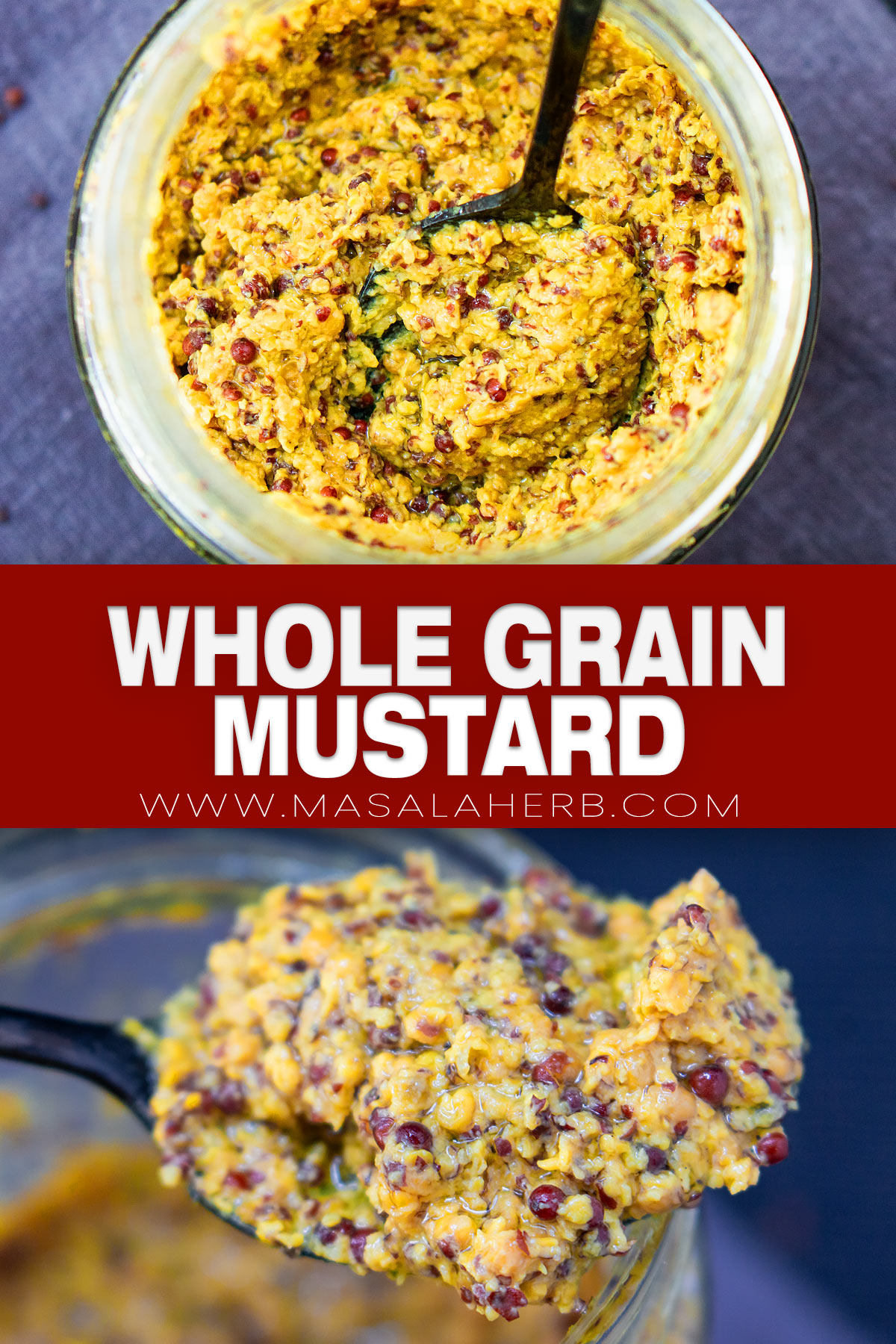

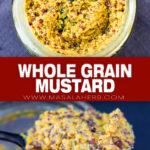
I just made this recipe yesterday and CAN NOT wait to try it in four weeks!! I did have to use a bit more vinegar as the seeds soaked it right up, so I hope that it’s still just as delicious. I also had a bit of trouble with my mortar and pestle so I threw it in my mini food processor at the end to create more of a paste. It already looks phenomenal.
Hi LeAnne, yes some seeds are dryer than others and soak up more vinegar. That's alright. Mini food processor is fine too. I think I will post a video with a food processor in it in the near future, if it can help others in the future. Thanks for sharing your experience with us. I bet your homemade mustard will taste great!
Has anyone ever tried this with a different oil, like refined coconut? I do not like to use canola or sunflower oil and wondering if it would still turn out with a different mild-flavored oil.
I haven't tried it with coconut oil but feel free to give it a go. Just pick a quality coconut oil. They are not all the same and some smell strong.
Have made this mustard recently. I have made a number of other whole grain recipes over many years. I selected this for trial because it was sweetener free. Most of my other efforts had sugar or honey added but were intended for more immediate use. I found this recipe very bitter at the time of bottling but in the 4 weeks recommended all the flavours had balanced out resulting in a very flavourful mustard of medium heat. I will be using this recipe again. I find if you require a variation in taste it is easy add sweetness or heat etc just prior to bottling but you need to know where you want to go and that takes a first trial. Thankyou for the recipe I am very pleased with it.
Thank you for sharing your experience with us, I think others will find the info super useful! 🙂
Hi,
Thanks for this wonderful recipe! The recipe instructions call for adding a total of 120ml of vinegar in two additions (4 fl. oz.), however the list of ingredients calls for 6 fl. oz or vinegar. Which quantity is correct?
Thanks, JP for noticing and letting me know. The correct quantity is 4 fluid ounces (120 ml). A small technical hiccup happened most recently when I converted the measurement, please excuse. I work with ml but convert to fl oz for convenience.
I love dijon mustard - I've never imagined of making it at home myself though. This is definitely inspiring! Thank you so much for sharing!
Has anyone actually made this? Lots of "can't wait to try it" and "sounds terrific" comments, but nothing about it actually tasting any good. Is it bitter? Lots of home-made mustard recipes turn out impossibly bitter.
Hi Tom,
Yep, I would love more feedbacks here too! When making homemade mustard and tasting it in the first few days you will notice a lot of bitterness. The trick is to, pound the seeds and use always quality vinegar but most importantly to allow the mustard paste to sit and develop all the flavors in the liquids. It can take up to 4+ weeks for a mustard paste to acquire the flavors you are looking for and only time can give that to a mustard paste. So in the first few days, the bitterness of the mustard seeds dominate the flavor here, but after a while, the seeds suck in the vinegar and the vinegar breaks down the "rawness" of the mustard seeds and the bitterness gets less by each day. I generally prefer preparing whole grain mustard pastes because it's easier to deal with the bitterness as you have yellow and dark brown/black mustard seeds and they both have a different level of bitterness. yellow mustard seeds are milder than the brown ones, so the balance is the key to a flavorful, good tasting mustard paste. By the way, this recipe is French and we have been doing it that way for ages. I hope this reassures you Tom, and you get to try out the whole grain mustard paste and that you get time and don't forget to leave us a comment after a couple of weeks with your feedback. Other users will appreciate it too! 🙂
This is helpful information. The first time I made mustard I used white wine instead of vinegar.
Do you store it in the pantry or the refrigerator? Thanks!
Hi Hannah,
I always store it in the fridge. Generally speaking, mustards are stored in the fridge after opening, in places like France.
Well, using white wine is an option too but I use vinegar because the acidity in the vinegar helps to release the mustard properties and thus creates a sort of emulsion. Especially brown or dark red mustard seeds are hard to crush and don't release flavors that easily compared to yellow mustard seeds. So, vinegar will accelerate your work a bit. Also, in France, they will use verjus, which is acidic raw grape juice. Someone is showing here how to make verjus if you are interested (I haven't tried it!). You can also try to mix vinegar with white wine. I mean, you can go crazy testing things to create different mustard flavors and that's what is so cool about that recipe!
Helene,
Hello, and thank you for sharing this recipe - Currently, I am using up my mustard recipe. However, when it comes time to mix up more mustard, I shall be giving this recipe a trial run.
On the topic of stowage:
Generally speaking; I do not believe it to be necessary to store mustard in the refrigerator. Especially if it is stored in a crock or glass vessel, kept out of direct sunlight, and not in plastic container. Mustard can retain it's flavor and freshness, two years or more kept in this manner.
Reason being, this condiment is "pickled", and maintains well, without the need of cold storage.
I personally, do not refrigerate - I have the corked crock placed on the countertop, which keeps it readily available for use at the spur of the moment, in six mos. or a year, it has always been fresh for me.
Blessings &
Buon Appitite ~
Oh man, I am a spicy mustard lover. Why the heck haven’t i thought to make it myself? thanks for the recipe!
Hi Helene
This recipe looks excellent. Can I just ask about the oil to pour on top - is it to keep the mustard moist so can be poured off or should it be stirred through after fermentation for serving?
Thanks!
Hi Noeni,
The oil helps to preserve the grainy mustard and it does give some moisture. You will see that after 4 weeks there won't be much oil left anyway. Basically, to answer your question, you can just stir through and your whole grain mustard will be ready for you to use it.
Do you let this stand in the fridge or at room temperature?
Hi Jake,
If you live in a cold country then you can leave it outside to stand in a cool and dry place. Something like a cool, but dry, cellar would do too. Just make sure to close the jar with the lid well. Try to avoid the fridge if possible, it dries up the mustard but if you don't have a cool and dry place, then this is the last option. Usually I keep it out in the tropics too, but in a dry, cool and dark place. The turmeric, mustard seeds and vinegar have anti fungal properties, so it will keep the mustard mold free.
Hi Helene, your mustard looks just like the real thing, I bet this is way more delicious than store bought.
WOW! This is such a beautiful and useful post. Bookmarked!
Thanks a lot for posting this wonderful recipe of the whole grain mustard paste. Loved the pics. So vibrant and mouthwatering.
Deepa
Goodness! This is so mouthwatering. I like it as a condiment with rice.
Wow. Wow. Wow. Wow. How did I miss this?! You made mustard from scratch?! How fantastic. Looks just incredible.
I would love to make my own whole grain mustard. I have bought it before ready made, but this sounds much better. At least I would know what is in it.
Does this recipe need to be put in sealed jars or should it be refrigerated?
Should this recipe be put in sealed jars and left out or should it be refrigerated?
Best way to preserve is sealed in jars and stores in a cool dry place such as the fridge. Hope that helps!
I like to learn how food is made from scratch and this one was fun. I never thought of making whole grain mustard from scratch and really interesting to know the process, Helene! Now I'm ready to eat sausages with this!
I bet this mustard is better than anything you could buy! Definitely could see dipping some tiny sausages in this. I had no idea how whole grain mustard was made so thanks for sharing this.
Love whole grain mustard in sauces and dressings. We used a Creole mustard at work that was whole grain. Yum!
I have never ever been brave enough to try my own whole grain mustard but you make it seem so easy.
Wow, thanks for all the helpful tips! I never considered making my own mustard, but now I just might! And I agree, mustard is kind of a forgotten spice!
Love this Helene. Must make some soon. My Dad has some green grapes on the vine. Maybe I should get a little adventurous.
Mmmmm, Helene that looks divine!
I eat eat wholegrain mustard most days for breakfast, on toast with a poached egg on top. I love it!
I actually grew some mustard for the seeds last year, and you've just reminded me they're still sat in a paper bag in the airing cupboard 'drying out'! I reckon (almost a year later!) they should be dry by now 😉
Janie x
Oh goodness me, this recipe would be awesome on one hubby's delicious grilled treats! It really looks wonderful! Hugs, Terra
I have mustard seeds and keep thinking I'm going to make whole grain mustard but haven't done it yet. You make it sound pretty easy and the recipe sounds great so I'm going to have to try it!
And here's the mustard! You know, I really thought the recipe for mustard must be more involved than this... it seems quite simple actually. Of course, now I need to find some mustard seeds... not that common but I'm sure I can find some somewhere. Looks lovely Helene - and really colourful too!
So true about the great variety of mustard found in Europe. I would love to have that selection here in the US. There are some German mustards that are one of the highlights of my visits there and I bring back as much as I can in my suitcase.
I'm so glad you shared a mustard recipe and if I ever do make my own mustard this is the one I would start with first.
Helene, whole grain mustard is one of my favorite condiments -- never thought to make it though. Thank you so much for the recipe! That last photo says it all.
Making your own mustard sounds like fun!
For me, it was just the reverse...I had no clue mustard was so widely used outside of Indian cuisine. In Bengal, we use it extensively, from seasoning to paste, and traditionally a sauce is prepared that is called 'kashondi'. This looks similar, and I would love to have a taste of it. Great post!
This is one condiment that I haven't seen made from scratch. I love a good whole grain mustard! Thank you for sharing!
I should make my own mustard too! I do buy wholegrain mustard seeds all the time, but never thought of making sauce out of them...
Thanks for sharing, Helene.
I thought I was the only one fussing about the poor quality mustard sauce available in India. I usually ask my hubby to procure it when he travels to Europe. However, I am going to try your recipe coz I am a fan of home made food. It is better and cheaper than store brought ones. Thanks for sharing dear 🙂
Bravo, Helene! Your mustard rivals those of the Dijon dynasty =) Love the tang of turmeric.
Your knowledge of the varieties of mustard seeds is awesome! (As the young kids would say=) )
I love *any* mustard! And mustard seeds... we used to buy a fancy one downtown but I'm definitely going to make it now!
I love this, Helene! My favorite sandwich condiment is moutarde a l'ancienne, which I buy at the French chain hypermarket, Carrefour. And because I do a lot of curries, I always have brown mustard seeds in the spice rack. It never occurred to me that I could make my own mustard! So silly when I think about it. I can't wait to give this a try! Thank you!
We are major mustard snobs! I have a bag of mustard seeds just waiting to be made in to mustard... someday! Yours looks amazing.
I eat a grainy mustard nearly every day AND I've been dying to make my own mustard since receiving some as a gift! You are an inspiration, Helene!!!
Oh I love mustard too and my mom uses the yellow seeds (available in Delhi) in her Fish curries!!I love grainy mustard with my hotdogs and this recipe sounds amazing Helene!!
Nothing like a homemade condiment to enjoy with your foods.And its healthy too!
JUST beautiful. I am a mustard addict! And I've always wanted to make my own! Thanks Helene!
I make mustard from time to time just for fun, but I'm lucky in that I can buy many different types of already prepared mustard. Yours looks fabulous - really nice. Thanks so much.
I never thought to make my own mustard and I love mustard, how silly of me! I really dig the fact that it has healthy oils and proteins, I had no clue.
Oh, how I would love to join you on that Mustard Trail! I'm a huge fan of whole grain mustards...my favorite...and yours looks just perfect, Helene :).
I find dark and yellow mustard seeds here, and have been infatuated with them ever since I discovered a roasted cauliflower recipe that uses them. I will absolutely make this mustard Helene! No matter how long I have to wait. Time flies by anyway.
I have never considered making my own mustard, which is strange now that I think of it, this looks possible!